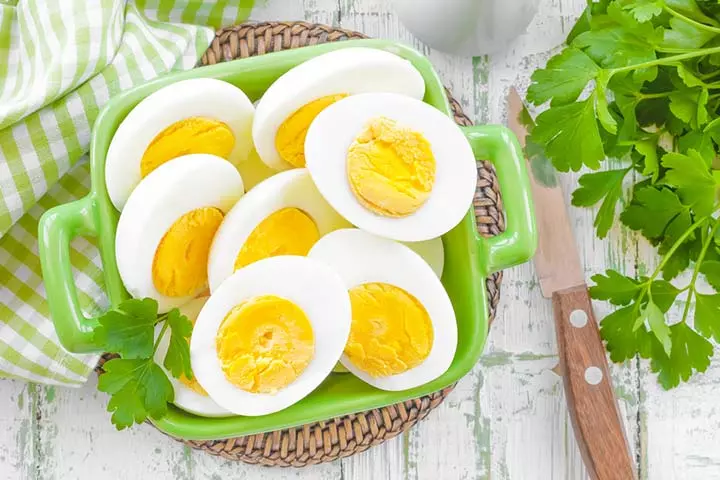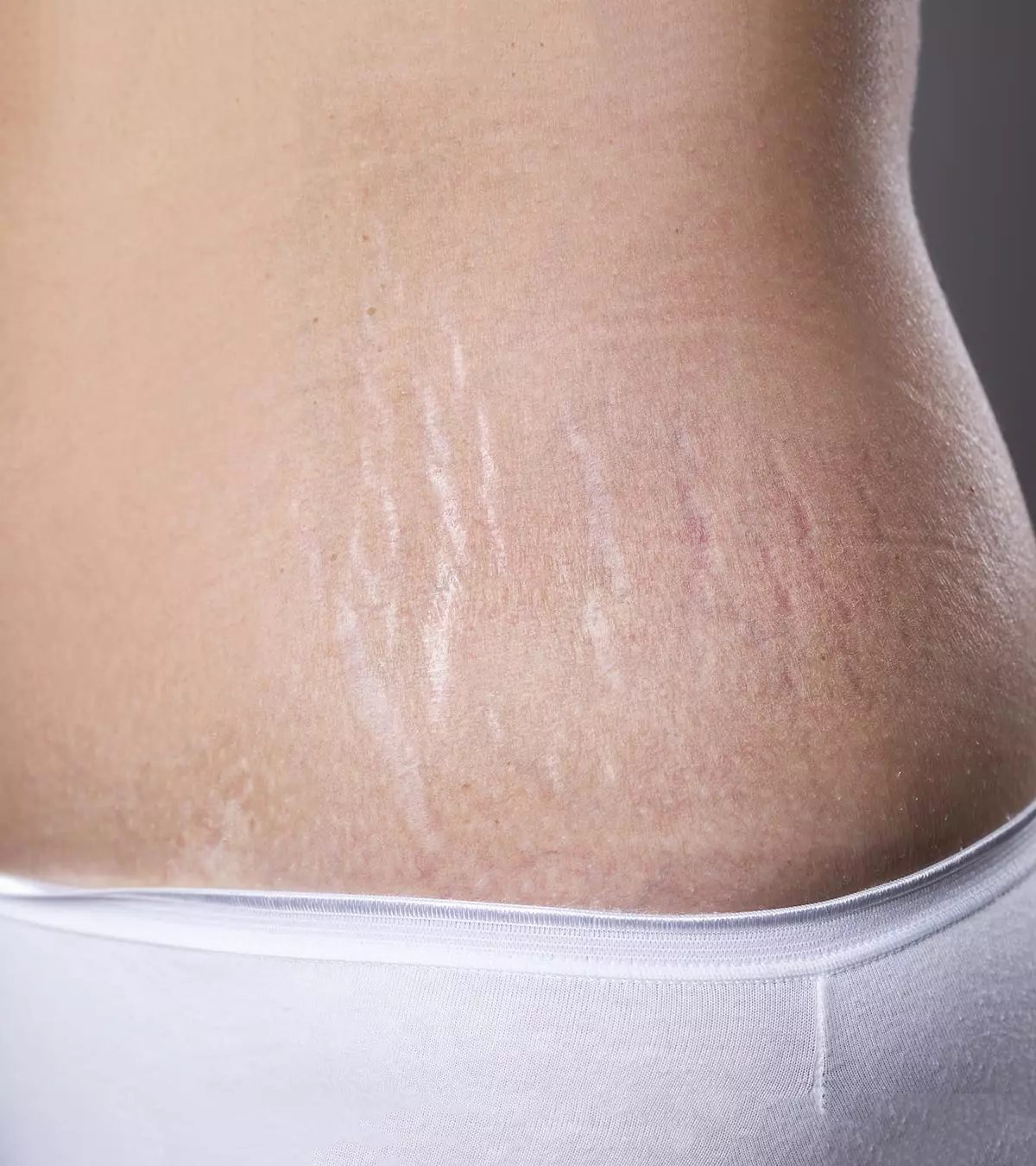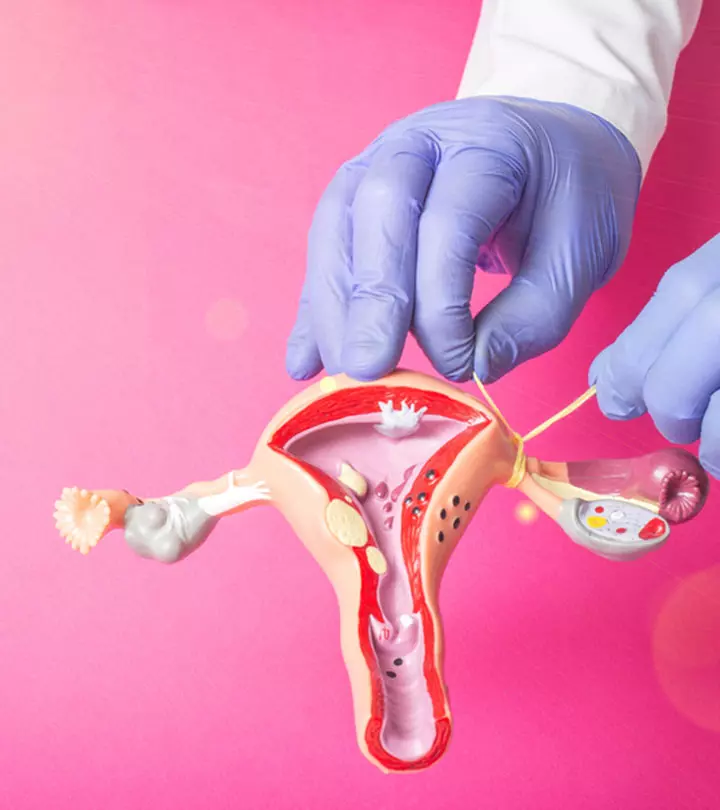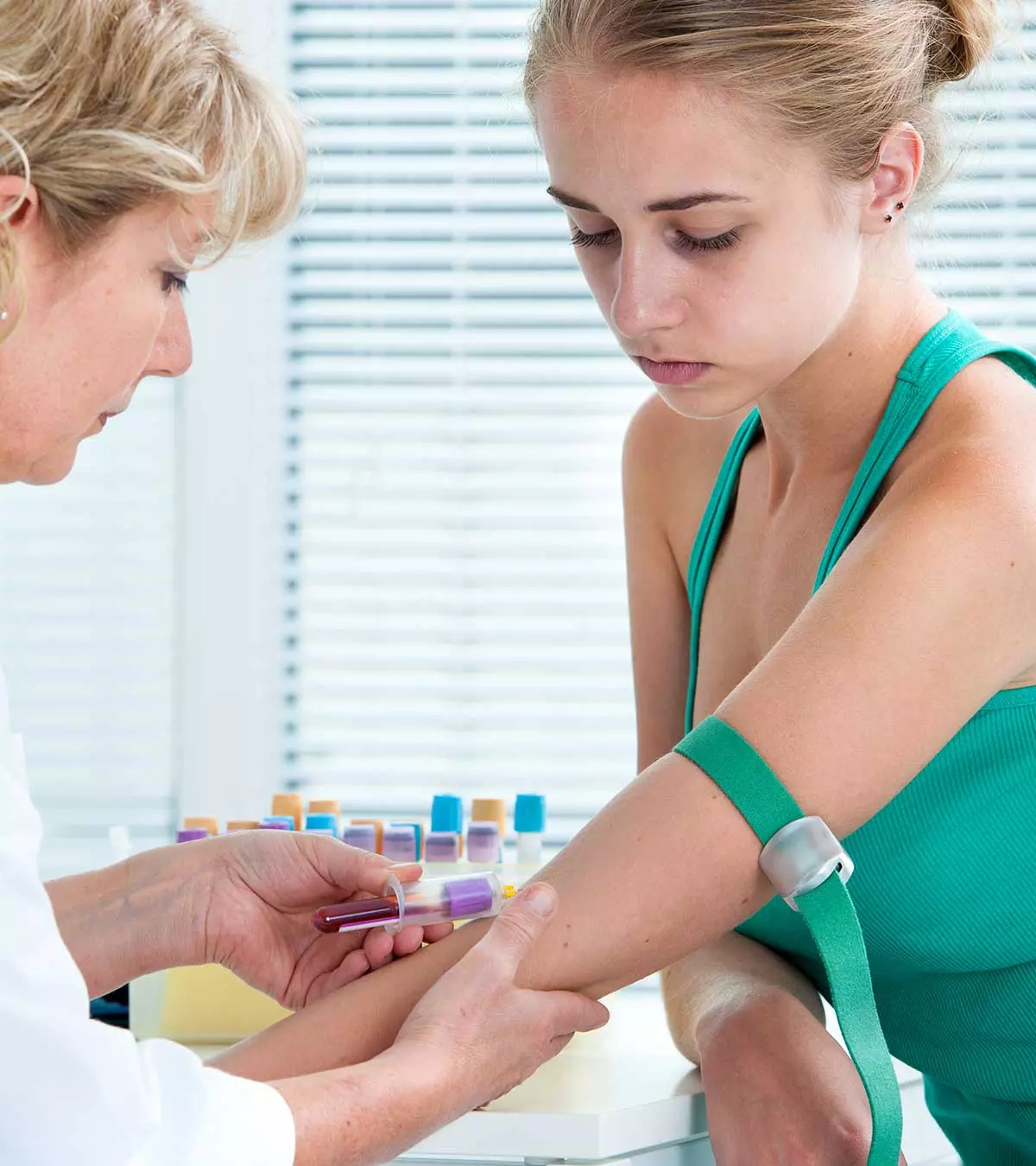
Image: ShutterStock
C-section is one of the most common surgical procedures; however, it is a major procedure and warrants special care (1). Hence, paying attention to your diet after C-section delivery is pertinent to hasten recovery and support optimum milk production.
You should consult a certified dietician or nutritionist to plan a well-balanced diet containing various foods from the different food groups.
Read on as we give you insight into the essential nutrients you should include in your diet, what to eat after a c-section for fast recovery, and some foods you should avoid eating. Also, we give you some tips to follow to maintain a healthy diet after delivery.
Key Pointers
- A well-balanced nutritious diet is essential after pregnancy to speed up the recovery process and provide ample nutrition to the baby.
- A diet rich in proteins, calcium, iron, multivitamins, and fiber is highly recommended after delivery.
- Carbonated or caffeine-containing drinks, alcohol, and spicy, gassy, or cold food should be avoided after a c-section.
- Taking supplements as advised by a doctor and frequent and small meals may help provide nourishment and strength, and facilitate digestion in the new mother.
- It is a good idea to consult a doctor before starting any new diet regimen postpartum.
Why Is Nutrition Essential Post Delivery?
Whether it is a vaginal delivery or a C-section, optimum nutrition speeds up the recovery and gives you the needed energy boost.
According to the Dietary Guidelines published by the US Department of Agriculture and endorsed by the American Dietetic Association, new mothers, who are breastfeeding, might require an additional daily intake of 450-500K calories. They also need additional amounts of vitamins and minerals (2).
A higher intake is recommended for women who are breastfeeding more than one baby or are underweight or who regularly indulge in physical activity. This is important to meet the nutritional needs of the mother and the growing baby. So, don’t go on a low-calorie diet during this time.
Essential Nutrients To Have After Cesarean Delivery
A balanced diet supplies you with all the macro and micro nutrients that are required for you and your growing baby.
Here are some of the nutrients that you should include in your post-pregnancy diet to recover fully after delivery – both normal and C-section (3).
1. Proteins

Proteins aid in the growth of new cell tissues and help in the healing process. Protein-rich foods facilitate tissue repair and maintain muscle strength after the surgery. You can eat lean protein sources like fish, eggs, chicken, dairy foods, meat, peas, dried beans, and nuts. These foods provide high-quality protein, which would also be the source of essential amino acids that are crucial for you and your baby (4).
While the recommended amount of daily protein intake for an average woman is around 0.8 g/kg body weight, an additional 25g is recommended for lactating women (5) (6).
 Point to consider
Point to consider2. Calcium
Calcium aids in the relaxation of muscles, strengthens bones and teeth, and helps in blood coagulation. The deficiency of calcium impacts bone-density and could also lead to the development of osteoporosisiA condition that causes the weakening of bones due to decreased bone mass and mineral density. . Therefore, it is important to include good sources of calcium in your diet (7).
Some of the good sources of calcium are milk, yogurt, cheese, tofu, kale, and spinach. The recommended daily intake of calcium for lactating women of ages 14 to 18 is 1,300mg, and for those older than 19 years is 1,000mg per day.
During breastfeeding, 250 to 350mg of calcium is transferred to the newborn (8).
Note: Vitamin-D is important to enhance the bioavailability of calcium. Therefore, it is wise to ensure that you include vitamin-D enriched foods in your diet, along with calcium-rich foods. You could also try sunbathing, which is another effective way to enhance vitamin-D levels.
3. Iron

Iron is essential to maintain hemoglobin levels in the mother. Whereas for infants, it is required to support proper neurological development (9). However, its demand during lactation is less when compared to pregnancy (7). To meet the needs, you could include iron-rich foods, such as egg yolk, red meat, oysters, figs, beef liver, dried beans, and dry fruits.
While you plan to add iron-rich food to your diet after delivery, practice caution, as an excess of iron can cause constipation. This could be an added concern in the early weeks after the surgery.
The recommended dietary allowance for iron is 10mg per day for women of ages 14 to 18 years, and 18mg per day for those older than 19 years (10).
4. Vitamins C
The recommended daily allowance is 115mg for lactating women of 14 to 18 years, and 120mg for those above 19 years (11).
Vitamin C helps strengthen your and your baby’s immune system. Optimum levels of vitamin-C are important for a mother post delivery, as it could support prompt healing by boosting collagen production. Whereas for babies, it is a key milk antioxidant that could help fight infections (11).
Breast-fed infants are well protected against vitamin-C deficiency (12). Thus, it is important that a mother’s diet includes vitamin-C rich fruits and vegetables, such as oranges, melons, papayas, strawberries, grapefruits, sweet potatoes, tomatoes, and broccoli.
Note: Vitamin-C is important to enhance the bioavailability of iron. Thus, it is wise to include vitamin C-rich foods along with iron-rich foods in your diet. For example, you can have spinach sandwiches with lemon water or eat an orange after a meal with kale and other iron-rich foods.
 Did you know?
Did you know?5. Multivitamins and multiminerals
Recovering after a cesarean section is very important and warrants proper nutritional care of the mother to ensure effective care of the baby. Therefore, it is wise to consume a well-balanced diet and follow the right meal-planning advice of a nutritionist. Also, you should follow the course of multivitamins and multiminerals as prescribed by your doctor.
6. Fiber

Fiber mitigates constipation, which, otherwise, causes undue pressure on the incisions formed after c-section. Thus, a diet rich in fiber is crucial. You could include plenty of whole grains, raw fruits and veggies, as they add roughageiThe dietary fiber in plant-based foods which cannot be digested fully and thus aid in smooth excretion. to your diet (13).
However, as you increase fiber in your diet, remember to maintain optimum water intake, as too much fiber could counteract, especially with less intake of water.
7. Others
- Drink water and fresh juices and soups to avoid dehydration and constipation. Fluids help in smooth bowel movement and recovery from the surgery. For better hydration, you may have low-fat milk, non-citrus juices (unsweetened), herbal teas, coconut water, and buttermilk.
- You may cook and consume fish, which contain healthy fats like omega-3 fatty acids, and eggs that provide zinc. It could also act as a good source of vitamin-E for your breastfeeding baby. A few other sources of healthy fats include nuts, seeds, and vegetable oil (14).
- Milk is not only an excellent source of calcium but also promotes the production of breastmilk. Cottage cheese, broth, and yogurt are good sources of calcium too. Yogurt supplies your body with calcium and zinc. In case you are lactose intolerant or a vegan, you can try other sources of calcium such as asparagus, Brussels sprouts, broccoli, kale, sesame seeds, etc. (15).
- You can also consult your nutritionist and try to include some spices and condiments that have known medicinal properties to support healing after cesarean delivery. For example, fenugreek, milk thistle, coriander seeds, fennel, Shatavari, etc. could be helpful post delivery (16). These are not only known for their galactagogueiFoods and herbs that increase and improve the supply of breast milk. properties but are also believed to heal the mother’s body after delivery.
- You can include clarified butter or ghee in your diet if you wish to. Generally, ghee is purported to develop heat and thus delay healing of the incision post c-section. However, there are no known studies to support this belief. Therefore, it would be wise to consult your nutritionist and consume ghee, which is a good source of conjugated linolenic acid, omega-3, omega-6, vitamin-A, D, and K. All these are essential nutrients for the mother as well as the breastfeeding baby (17).
Even as you take care to include healthy foods in your diet, you need to eliminate or avoid certain unhealthy foods.
Foods To Avoid After C-Section

You should avoid highly processed, refined, high-fat foods, especially because your physical activity is low after C-section. They may just add to your weight and reduce your metabolism. Avoid spicy foods as they can lead to gastric problems. Practice mindful eating, maintain variety in your diet, and consume everything in moderation.
Here are a few more foods that are best avoided:
- Carbonated drinks, which may cause gas and flatulence.
- Citrus juices should be taken with caution. You may take them in small amounts and then increase to moderate quantities.
- Caffeinated drinks like coffee and tea have diuretic properties. Therefore, have them moderately.
- Continue to stay away from alcohol as it can impair your ability to produce milk.
- If you have bloating and gas, then you may stop eating gas-forming foods such as cabbage, cauliflower, broccoli, lady’s finger and onions, for a few days. You may also eat white lentils, red kidney beans, chickpeas, black-eyed beans, and green peas in small quantities and one variety at a time.
- Avoid spicy foods, especially the ones not prepared at home.
- Avoid cold foods and drinks. They may make you catch a cold.
Things To Remember

Follow these basic tips to ensure you get the best out of what you eat:
- Have small meals throughout the day instead of consuming three heavy meals. It is better for digestive health and keeps blood sugar balanced.
- Avoid gulping down your food. Instead, take some time to chew it slowly. It may be difficult for you to have a relaxing meal while having a newborn around, but you can ask your family members to look after your baby for some time.
- With a newborn, you may not get enough sleep. So, try to rest whenever possible. Sleep will help your body repair and heal better.
- Try to eat home-cooked meals as you can include lots of fresh ingredients.
- If you’re unsure about the safety of a food, consult a healthcare professional for personalized dietary advice.
Frequently Asked Questions
1. Can I drink milk after C-section?
After any surgery, such as the C-section, you would be asked to follow a soft diet – a diet low in fiber, easily digestible, and soft in texture. Milk and other dairy products could constitute a soft diet; hence, you may consume milk after C-section (18).
2. Can I eat bread after a cesarean?
You may consume bread and its varieties after cesarean. As a part of the soft diet, you may be asked to consume white bread at the beginning (18). As your body becomes tolerant to fiber, you may shift to whole foods like whole wheat and other multigrain bread after your doctor’s approval.
3. Is it necessary to take supplements after a C-section delivery?
Taking supplements after a C-section delivery can help in the healing process. Some common supplements one can have include iron, fiber, vitamins C and D, quercetin, and postnatal multivitamins. However, it is important to consult a doctor about which supplements you need to take instead of starting the course on your own (21) (22).
4. How can I maintain a healthy weight after a C-section delivery?
Engaging in low-intensity physical activities such as yoga or walking, having a well-balanced diet, breastfeeding, getting postnatal massages, and sleeping adequately can help maintain a healthy weight after cesarean delivery.
5. What are some healthy snacks for postpartum recovery after a C-section delivery?
Healthy snacking options for postpartum recovery after a C-section include soups, broths, yogurt, and cottage cheese.
Good postpartum nutrition is essential for optimal recuperation, whether you had a C-section or a vaginal delivery. It may also alleviate unhealthy food cravings. However, because cesarean birth is a major operation requiring special attention, you must pay extra attention to your diet after a C-section delivery. Since your body requires all nutrients and nourishment, your diet should include all nutrient-dense foods, preferably home-cooked meals, while practicing portion control or avoidance of junk and spicy foods, alcohol, caffeine, and carbonated beverages. You should also drink enough fluids, get plenty of rest, and do some gentle exercises as directed by your doctor.
Infographic: Beneficial Nutrients For The Mother After A C-Section
After a cesarean delivery, new mothers need to focus on their recovery and nutrition. So, their essential nutrients include protein, iron, calcium, and vitamins D and B12. These nutrients support the healing process and help maintain overall health. So, learn more about the food sources of their nutrients in the infographic below. Illustration: Momjunction Design Team
Illustration: Diet After Cesarean Delivery: Essential Nutrients To Take

Image: Stable Diffusion/MomJunction Design Team
References
1. Caesarean sections should only be performed when medically necessary; WHO
2. When breastfeeding, how many calories should moms and babies consume?; National Institute of Health; U.S Department of Health and Human Service
3. Michelle A. Kominiarek; Nutrition Recommendations in Pregnancy and Lactation; NCBI (2016)
4. Amino acids; Medline Plus; U.S National Library of Medicine
5. How much protein do you need every day?; Harvard Health Publishing
6. Michelle A. Kominiarek and Priya Rajan; Nutrition Recommendations in Pregnancy and Lactation; NCBI
7. Meeting Maternal Nutrient Needs During Lactation; Nutrition During Lactation; National Center For Biotechnology Information
8. Calcium; National Institute of Health; US Department of Health and Human Services
9. Iron; Breastfeeding: Centers For Disease Control And Prevention
10. Foods high in iron; Health Direct
11. Vitamin C; National Institutes of Health; US Department of Health and Human Services
12. Salmenperä L.; Vitamin C nutrition during prolonged lactation: optimal in infants while marginal in some mothers.; National Center For Biotechnology Information
13. Recovery after a cesarean birth; Kaiser Permanente (2019)
14. Fats and Cholesterol; Harvard T.H.Chan School of Public Health
15. Calcium; Eat Right; American Academy of Nutrition and Dietetics
16. Rania MohamedAbdou and MonaFathey; Evaluation of early postpartum fenugreek supplementation on expressed breast milk volume and prolactin levels variation; Science Direct
17. 9 Health Benefits of Ghee; ECPI University
18. Gastrointestinal Soft DietOverview; Cleveland Clinic
19. Advice about eating fish; FDA
20. Guavas, common, raw; USDA
21. The Do’s and Don’ts of Healing from a C-Section; Intermountain Healthcare
22. How to Recover From A C-Section; Anna-Maria Nutritionist Herbalist and Doula
Community Experiences
Join the conversation and become a part of our nurturing community! Share your stories, experiences, and insights to connect with fellow parents.
Read full bio of Dr. Christian Pope
Read full bio of Swati Patwal
Read full bio of Rebecca Malachi
Read full bio of Aneesha Amonz



















